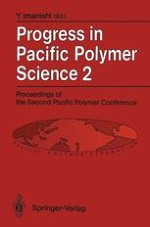1992 | OriginalPaper | Buchkapitel
Viscoelastic Properties of Semidilute Polyelectrolyte Solutions
verfasst von : I. Noda
Erschienen in: Progress in Pacific Polymer Science 2
Verlag: Springer Berlin Heidelberg
Enthalten in: Professional Book Archive
Aktivieren Sie unsere intelligente Suche, um passende Fachinhalte oder Patente zu finden.
Wählen Sie Textabschnitte aus um mit Künstlicher Intelligenz passenden Patente zu finden. powered by
Markieren Sie Textabschnitte, um KI-gestützt weitere passende Inhalte zu finden. powered by
Zero-shear viscosity η° and steady-state complinance Jc of poly(N-methyl-2-vinylpyridinium chloride) solutions were measured in the absence and presence of added-salt over a wide range of polymer concentration. The polymer concentration dependence of η° in semidilute regions increases with increasing added-salt concentrations Cs and almost agrees with that for non-ionic polymers in good solvents at high added-salt concentrations. JC in dilute regions depends on molecular weight M, polymer concentration C and Cs more strongly than that of non-ionic polymer solutions, as given by Jo ∝ M-2Cs. In entangled regions, on the other hand, Jc depends on polymer concentration only in the same manner as that of non-ionic polymer solutions, but its concentration dependence is weaker than that of non-ionic polymer solutions, as given by Je∝C-1.3. Moreover, the polymer concentration dependence of the weight-average relaxation time tw increases with increasing added-salt concentration in the semidilute region for η° and the entangled region for Jc. These viscoelastic properties of entangled-polyelectrolyte solutions can be well explained by the reptation model assuming that the correlation lengths related to entanglements are determined by the electrostatic interactions evaluated from the Donnan equilibrium.
